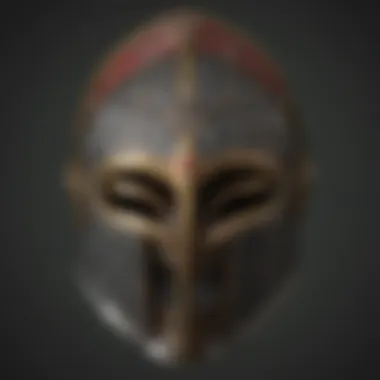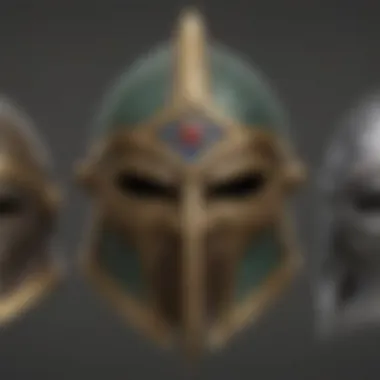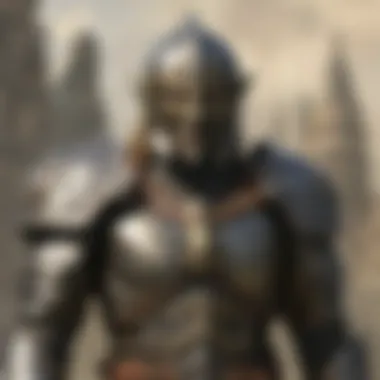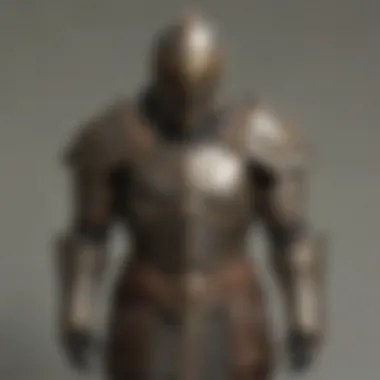The Significance of Helm Armor in the Zelda Series


Intro
Helm armor has been an enduring element within the Zelda series, serving not just as a protective gear but also as a vital piece of its lore and gameplay mechanics. This introduction delves into the various facets of helm armor, setting the stage for a comprehensive exploration of its significance throughout the timeline of Hyrule's legendary tales.
The Role of Helm Armor in Zelda
From the classic The Legend of Zelda to the modern Breath of the Wild, helm armor has evolved in form and function. It provides essential defense against enemies while often embodying key characteristics of the game's narrative and world-building.
Through various iterations, helm armor reflects local cultures and challenges, enhancing the player's experience and strategic options. Each iteration offers unique attributes, often tying back to the historical context of the game and enriching the player's connection to both the characters and the overarching storyline.
This article aims to dissect these layers, presenting an in-depth understanding of helm armor's role across different titles and highlighting its implications for gameplay strategy and character development. By dissecting the armor's historical context and gameplay features, we aim to enhance appreciation for this significant aspect of the Zelda universe.
Prelude to Helm Armor
Helm armor plays a vital role in the Zelda franchise, serving both practical and narrative purposes. In the games, helmets are not merely decorative items; they possess various attributes that affect gameplay dynamics, character development, and thematic depth. An understanding of helm armor allows players and enthusiasts to appreciate the intricacies of the gameplay and the stories conveyed throughout the series.
By looking into the definition and intended purpose of helm armor, we can unpack how these pieces enhance the gaming experience for players. Furthermore, understanding the historical context within the Zelda franchise can clarify how these elements became integral to the designs and mechanics of the games we enjoy today.
Definition and Purpose
Helm armor refers to the protective headgear worn by the protagonist, Link, in various titles of the Zelda series. Each helmet type provides specific benefits, such as increased defense against damage, enhancements to abilities, or resistance to elemental effects. For example, the Iron Helmet boosts defense, while the Zora Helmet allows the wearer to swim more efficiently in water. Therefore, choosing the appropriate helm can significantly alter a player's strategy during combat and exploration.
The purpose of helm armor extends beyond mere protection. Many helmets incorporate elements relevant to the storyline and character growth. They serve as symbols of Link's journey, obstacles overcome, and milestones achieved. Thus, helm armor adds layers to gameplay, linking function and narrative—returning players to a notion of a hero's evolution in Hyrule.
Historical Context within the Zelda Franchise
Examining the historical context of helm armor reveals its evolution alongside the series itself. In early games such as "The Legend of Zelda" released in 1986, headgear was simplistic and functioned primarily to increase defense stats. As the franchise progressed, developers expanded upon these concepts with more intricate designs and capabilities. The introduction of titles like "Breath of the Wild" put helm armor front and center, offering a vast array of choices and crafting possibilities, showcasing advancements in graphics and gameplay mechanics.
Helm armor reflects broader gaming trends and innovations. It highlights how the series adapts to player expectations, demanding deeper engagement and strategic planning. In newer installments, helmets like the Champion’s Tunic from "Breath of the Wild" challenge conventions by providing unique powers that can transform gameplay, thereby deepening immersion and individual player experience. The evolution of helm armor illustrates not just the growth of the Zelda series, but also its responsiveness to the gaming landscape.
The Evolution of Helm Armor Design
The evolution of helm armor design in the Zelda series reflects both technological advancements and the shifting narratives within the games. This aspect reveals how the visual representation and functionality of helm armor have adapted to players' expectations and gameplay mechanics. Designers have continually reimagined these elements, ensuring that helm armor not only serves a protective purpose but also enriches the player's experience.
Early Designs and Concepts
In the early Zelda games, helm armor was often simplistic yet effective. The initial designs were mostly dictated by the limitations of the hardware at the time, leading to basic shapes and colors. For example, in the original The Legend of Zelda, the helm armor was depicted with pixelated graphics, focusing primarily on form over detail. The iconic green tunic and cap became synonymous with Link, while the helm, though less defined, still symbolized the hero's readiness for battle.
The purpose of helm armor in these early games was straightforward: provide a means for Link to sustain damage in his journey through Hyrule. The lack of complex mechanics in gameplay meant that players primarily viewed helm armor as a cosmetic feature aligned with Link's identity. In The Legend of Zelda: A Link to the Past, designers took a step forward by introducing a broader variety of helm styles. These included not only knights' helmets but also other cultural influences. Such diversity began to establish unique identities for different armor types, enhancing their significance in gameplay.
Modernizations in Recent Titles
With advancements in gaming technology, the design of helm armor has become increasingly intricate in recent titles. Games like Breath of the Wild exemplify this evolution, showcasing varied aesthetics and functionalities. Helmets are no longer just protective gear; they embody unique traits that influence gameplay significantly. Different sets of armor now grant various abilities, such as increased stealth or improved defense against elemental threats.
In The Legend of Zelda: Breath of the Wild, for instance, each helmet comes with specific advantages—like the Barbarian Helm, which enhances attack power, or the Snowquill Headdress, essential for survival in cold climates. Furthermore, the ability to customize and upgrade helm armor adds a layer of depth, allowing players to tailor their experience according to their playstyle.
This modernization serves a dual purpose. It retains the foundational role of protecting Link while simultaneously aligning with contemporary gameplay design principles that prioritize player agency and strategy. The shift from simplistic designs to elaborate, multi-functional helm armor illustrates the franchise's commitment to evolving with its audience while remaining true to its roots.


"The development of helm armor in the Zelda series not only exhibits shifts in design but also mirrors changes in gameplay engagement and player expectations."
Types of Helm Armor in Zelda Games
Helm armor plays a crucial function in the Zelda series. Different types of helm armor offer various attributes that enhance gameplay and influence overall strategy. Understanding these types gives players insight into how to optimize their approach in battles and exploration.
Basic Helmets and Their Functionality
Basic helmets are the initial offerings found in several Zelda games. These helmets typically reduce damage taken from enemies and provide necessary protection during early challenges. Their designs are often simplistic, focusing on utility rather than visual flair. For example, in "The Legend of Zelda: Breath of the Wild," players can find the Soldier's Helm, which grants basic defensive capabilities essential for survival in tougher environments.
Functionality of basic helmets includes:
- Damage Reduction: Reduces the impact from enemy attacks.
- Basic Defense: Helps players withstand initial threats without overwhelming progression.
- Accessibility: Generally easy to acquire, meaning players can equip themselves with fundamental protection early in their journey.
These helmets may not possess special abilities or enhancements, but they are vital for establishing a strong foundation in terms of defense. Without adequate protection, players may struggle to progress.
Unique Legendary Helms
Unique legendary helms present a high point in the progression of armor collection. These special items are often tied to significant quests or challenges, granting players more than just protection. They frequently come with enhanced attributes or unique abilities.
For instance, the Helm of the Wild in "Breath of the Wild" not only increases defense but also enhances Link's ability to avoid detection from enemies. Legendary helms add depth to the gameplay by:
- Introducing Special Abilities: Many legendary helms grant powers that can shift combat dynamics, such as increased stealth or elemental immunity.
- Representing Achievement: Acquiring these unique items often requires completing complex tasks or defeating powerful foes, providing players with a sense of accomplishment.
- Strengthening Character Identity: Each legendary helm often symbolizes a facet of Link's journey or character development.
These helms contribute significantly to the narrative by intertwining gameplay mechanics with story themes and player progression.
Crafting and Custom Helmets
Crafting and custom helmets represent a modern approach to helm armor within the Zelda series. Incorporating crafting mechanics allows players to engage more deeply with the game world. Instead of passively acquiring items, players actively create helmets tailored to their playstyle.
In "Breath of the Wild," the crafting system encourages experimentation, allowing players to combine materials to forge custom helmets that fit their desired attributes. This aspect of gameplay emphasizes:
- Customization: Players can shape their strategy by selecting the materials that enhance specific stats according to their preferences.
- Resource Management: Collecting materials for crafting adds an additional layer of depth, requiring players to explore Hyrule thoroughly.
- Creativity: Players have the freedom to design helmets that reflect their unique gaming style.
Crafting and customizing helmets enhance player engagement and add personal investment in the game mechanics, making the experience more immersive.
As a conclusion, the variety of helm armor in the Zelda games highlights the intricate connection between gameplay, character growth, and narrative depth. Each category serves a purpose that enriches the overall experience for players.
Gameplay Mechanics Related to Helm Armor
The mechanics of helm armor in the Zelda series serve as a foundational aspect that influences both gameplay and player strategies. Helm armor is not simply an aesthetic choice; it carries substantial implications for the character's defensive capabilities and overall gaming experience. Analyzing these mechanics reveals how they shape combat scenarios and push players to adapt their approaches based on the type of helm equipped.
Armor Rating and Damage Reduction
The armor rating is a crucial factor that players must consider when donning various helms. Each helm within the game comes with a specific rating that determines how much damage Link can mitigate from enemy attacks. Higher armor values lead to less damage taken, giving players an edge in difficult battles. Certain helms are designed specifically for heat resistance or to offer protection against elemental forces, adding layers of tactical depth at play.
For instance, the Barbarian Helm is known for its high attack power enhancement, while the Soldier Helm distinctly amplifies defensive capabilities. Understanding the interactions of these values helps players make strategic choices about which helm to equip for specific encounters.
Additionally, running into enemies with high-damage output while wearing a weaker helm can drastically alter the course of gameplay. Thus, armor rating does not merely represent numbers; it reflects a player’s ability to navigate challenges.


Special Abilities and Enhancements
Helm armor in the Zelda series also introduces special abilities and enhancements that enhance player tactics. Many unique helms provide additional bonuses beyond mere protection. For example, the Night's Helm offers stealth bonuses, allowing Link to navigate through certain areas without alerting enemies. This can dramatically change how players approach stealth-based missions, emphasizing unorthodox strategies that rely on evasion rather than confrontation.
Other helms, such as the Zonai Helm, can grant temporary buffs or special powers during combat. These abilities encourage players to experiment with different hem types based on the challenges they face or the environment they explore.
In summary, the gameplay mechanics tied to helm armor significantly empower players by directly influencing their approach to combat and strategy.
The interplay between armor rating and special abilities allows for a diverse set of gameplay options, promoting creativity and adaptability. As each player learns to master these mechanics, they further shape the narrative and strategic landscape of their journey through Hyrule.
Cultural Significance of Helm Armor
Helm armor in the Zelda series functions not merely as a protective gear. It embodies deeper meanings and reflects the culture within the games. Its significance can be observed through various elements that enhance both gameplay and storytelling.
Symbolism in Game Narratives
Helm armor carries various symbolic meanings throughout the Zelda franchise. Each helmet is not just an item; it represents Link's journey and the trials he faces. For example, the iconic Master Sword and its legendary armor, which includes notable helms, signify courage and heroism.
The design often reflects the region's culture, whether it be Hyrule or the darker lands of Termina. Players recognize that equipping a particular helm also connects them to the narrative arcs unfolding in that environment. Certain helms, like the Fierce Deity Mask, symbolize transformation and the growth of the protagonist. This depth in items illustrates how armor can drive the story forward, enhancing the player's emotional experience and engagement with the vast lore of the series.
Reflecting Real-World Armor Design
The design of helm armor in the Zelda series does not emerge from a vacuum; it echoes real-world historical armors. The graphical representation balances between authenticity and artistic style. For instance, the knightly visors and helmets seen in Ocarina of Time or Breath of the Wild draw inspiration from Medieval and Renaissance armors.
These historical elements contribute to realism, allowing players to feel as if they inhabit a world grounded in some semblance of truth. The different types of armor provide players with visual cues about the kind of combat they may face. Some helms appear heavy and formidable, suggesting protection against brute strength, while others are lightweight, indicating agility and speed.
In summary, the cultural significance of helm armor is evident. It encapsulates storytelling, historical inspirations, and even the emotional growth of iconic characters. Such elements enrich the video game experience, allowing players to experience not only strategy but also deeper connections to the narrative.
Helm Armor and Character Development
Helm armor plays a critical role in the character development of both the protagonist, Link, and the broader narratives within the Zelda series. The design and functionality of helm armor contribute not only to gameplay mechanics but also to thematic elements that shape characters and their journeys. This connection between helm armor and character development is significant, as it illustrates how physical attributes can symbolize growth, resilience, and transformation within the game.
Influence on Link's Persona
Link, as the central character in the series, embraces various forms of helm armor throughout his quests. Each helmet changes not only his defense but also his identity and perception in the eyes of other characters and the world around him. For example, the iconic Hylian Shield and corresponding helm present Link as a heroic figure, representing the courage and strength associated with his mission. Contrast this with the Dark Link helm, which portrays a more sinister aspect of his persona, highlighting the inner conflict he faces against darker forces.
By donning specific helm armor, players can project different facets of Link's character. This layer of identity allows for a more nuanced storytelling experience, where players feel a connection with Link’s journey and his evolution through the game. The visual representation that helm armor provides not only enhances gameplay aesthetics but also contributes deeply to the narrative framework within which Link operates.
The Role of Helm Armor in Character Growth
Helm armor does more than serve as a protection mechanism; it facilitates Link's personal growth across the series. As players progress, they often acquire stronger and more unique helmets that symbolize the challenges Link has overcome. The gradual improvement in armor quality mirrors Link's own evolution from a novice to a seasoned warrior.
In many instances, specific helm armor comes with unique abilities or enhancements. For instance, the Phantom Armor not only boosts defense but also signifies Link’s mastery over his fears and challenges. Obtaining such pieces serves as a narrative device that marks pivotal moments in Link's journey.
Moreover, the decision-making process regarding which helm to wear can reflect a player's strategic approach to gameplay. This choice often aligns with thematic elements of courage, wisdom, and power—core tenets of the overall Zelda lore. Through helmets like the Majora’s Mask or the Fierce Deity Mask, players engage with the duality of light and darkness that characterize Link’s trials in the games.
In summary, helm armor is not merely an accessory; it is a vessel of character development that provides insight into Link’s persona and growth. As players navigate through the Zelda series, the significance of helm armor becomes an integral part of understanding Link as a character, as well as the intricate storytelling that defines this beloved franchise.


"The helmets Link wears are not just acts of protection; they tell a story about his character and growth throughout the series."
Understanding these aspects enhances the appreciation for both helm armor and its profound impact on character development within the Zelda universe.
Player Strategies Involving Helm Armor
Helm armor in the Zelda series offers players various strategic advantages that can significantly affect gameplay. It is crucial to understand how to leverage helm armor to enhance combat efficiency and overall survival. Helm armor not only provides protection but also allows for the development of tailored strategies based on specific circumstances in each game. The significance of helm armor cannot be understated, as it acts as more than just an aesthetic feature—it contributes to a robust gameplay experience.
Optimal Combinations for Combat
In the Zelda series, players can create optimal combinations of helm armor and other equipment to maximize their combat effectiveness. Different helms synergize well with various weapons and armor sets, allowing for unique builds. For example, wearing the Barinade Helm while equipping a Master Sword can provide an essential balance of offense and defense, ensuring that Link can withstand attacks while dealing significant damage.
Players should consider the following combinations:
- Elemental Resistance: Using the Fierce Deity Helm in conjunction with elemental armor grants players increased resistance against specific attacks. This can be especially beneficial during boss fights.
- Stat Modifications: Integrating the Hylian Shield with the Zora Helm enhances swimming abilities while still providing decent protection during encounters.
- Class Synergy: Pairing the Giant's Helm with heavier armor sets allows players to maximize their damage output while absorbing more hits. This combination can create a formidable tanking strategy.
By understanding these optimal combinations, players can tailor their strategies according to their preferences and what challenges they face in the expansive world of Hyrule.
Defensive Tactics in Gameplay
Defensive tactics involving helm armor are critical for survival, especially in the more challenging sections of the games. Different helms can provide various defensive bonuses, making it essential to choose wisely during battles. Players should adopt the following strategies:
- Understanding Helm Attributes: Each helm often has unique attributes that provide specific defensive benefits. Helmets like the Knight's Helm offer enhanced defense against physical damage, while the Snowquill Heelm protects against cold environments.
- Timing Dodges and Blocks: Knowing when to rely on a helm's defensive capabilities versus using agility can dramatically change an outcome in combat. For instance, using the Royal Guard Helm allows players to absorb a blow and then counterattack effectively.
- Gear Switching in Combat: Players should switch out helmets during critical moments. If a encounter features strong elemental attacks, quickly swapping to a helm with elemental resistance can be lifesaving. For instance, using the Gerudo Helm can reduce damage from fire attacks during a blaze.
"Your strategy should not solely rely on one piece of armor; adaptability is the key to mastering combat in the Zelda universe."
Future Directions for Helm Armor in Upcoming Titles
The trajectory of helm armor in the Zelda series is poised for exciting developments. Understanding these future directions is essential for Zelda enthusiasts, as they not only anticipate gameplay innovations but also reflect on how these updates might enrich the narrative universe. Future armor designs can bridge tradition with modern gaming expectations, merging aesthetic appeal with functional versatility.
Predicted Trends in Armor Design
Based on previous developments, several trends are likely to emerge in helm armor design. Firstly, customization will take center stage. Players increasingly desire personal expression in their gaming experiences, prompting developers to enhance crafting options. This may include unique designs based on various in-game achievements or quests, allowing players to showcase their personal journey through Hyrule.
Additionally, the progression of technology in graphics can lead to more intricate armor details, making helmets not only protective gear but also pieces of art. The usage of dynamic textures that change with environmental factors or player activities could enhance immersion.
Finally, the integration of diverse cultural inspirations can evolve the aesthetic of helm armor. Drawing from varied historical armor styles may offer richer visual storytelling.
Potential New Mechanics
Innovations in mechanics can greatly affect how helm armor is utilized in the game. It’s reasonable to foresee the introduction of situational bonuses tied to specific helmets. For instance, wearing a specific helm may provide increased agility in certain terrains, or enhance stealth during critical quests. This would encourage players to choose their armor based on tactical needs rather than simply favoring aesthetics.
Moreover, the possibility of integrating helm armor with environmental interactions is an exciting avenue. Perhaps certain helmets could grant elemental resistances or even enhance interactions with specific NPCs, further deepening gameplay strategies.
Culmination
In summing up the extensive examination of helm armor throughout the Zelda series, it is clear that these items transcend mere aesthetics and serve as pivotal components in gameplay and narrative development. Helm armor emerges not just as protective equipment; it symbolizes bravery, growth, and strategic decision-making within the universe of Hyrule. Understanding helm armor is essential for appreciating its dual role in enhancing both player experience and the intrinsic lore of the games.
Summary of Key Points
- Importance in Gameplay: Helm armor has significant gameplay mechanics connected to protection and ability enhancements, influencing how players engage with various challenges. It is critical for players to select the right helmets to optimize their performance against enemies.
- Cultural Significance: The design and implementation of helm armor are intertwined with the cultural themes presented in the series. Symbols and motifs found in the armor reflect broader cultural archetypes, thus enriching the narrative depth of each title.
- Character Development: Helm armor plays an important role in character development, particularly for Link. Each piece of armor acquired often signifies a stage in the hero's journey, reflecting growth in skills and abilities.
The Lasting Impact of Helm Armor in Zelda Lore
Helm armor has left a remarkable legacy within Zelda lore, serving as an enduring element that evokes nostalgia for long-time fans. As players continue to explore the evolution of helm designs and the variety of mechanics tied to them, they contribute to a deeper comprehension of the overarching narrative. Helm armor is often seen as not simply a functional piece of gear but as a crucial storytelling device. This blend of gameplay and narrative enriches the immersive experience of exploring Hyrule, ensuring that helm armor remains a point of fascination and analysis for gamers and scholars alike.





